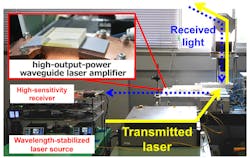Mitsubishi Electric tests wind lidar and water vapor DIAL for early forecasting of torrential rain
Mitsubishi Electric (TOKYO: 6503) has started demoing a new laser-based system equipped with wind lidar and water vapor DIAL (differential absorption lidar (DIAL) as measuring methods for the early forecasting of torrential rain. The system incorporates a newly developed high-output-power waveguide laser amplifier that delivers what Mitsubishi believes to be the world's highest output, 15.8 mJ, using a single-frequency pulse laser in the 1.5 μm wavelength region (which does not reach the human retina and is thus "retina-safe," although light at this wavelength can certainly damage the cornea).
The tests are expected to demonstrate that the system simultaneously measures water vapor in the air and upward air currents—which cause cumulonimbus clouds—more quickly, more accurately, and in a wider region compared to conventional alternatives. Going forward, Mitsubishi Electric expects to make further improvements prior to launching a commercial system for the extra-early forecasting of torrential rain.
The wind lidar and water vapor DIAL demonstration system will be exhibited at CEATEC JAPAN 2018 at Makuhari Messe exhibition complex in Chiba, Japan from October 16 to 19, 2018. The new system, which is based on a conventional wind lidar that Mitsubishi Electric released on May 28, 2014, has been enhanced for the measurement of atmospheric water vapor. It transmits laser beams from the ground to simultaneously measure the amount and distance of water vapor as well as the speed and direction of wind.
Extreme weather-related disasters are on the rise worldwide. In the case of torrential rain, early warnings must be issued as early as possible to enable communities to evacuate to safety. With conventional weather radars, however, cumulonimbus clouds can only be observed after they have formed, making it difficult to forecast torrential rain in time to carry out evacuations adequately.
Source: http://www.mitsubishielectric.com/news/2018/1011-a.html
About the Author
John Wallace
Senior Technical Editor (1998-2022)
John Wallace was with Laser Focus World for nearly 25 years, retiring in late June 2022. He obtained a bachelor's degree in mechanical engineering and physics at Rutgers University and a master's in optical engineering at the University of Rochester. Before becoming an editor, John worked as an engineer at RCA, Exxon, Eastman Kodak, and GCA Corporation.

